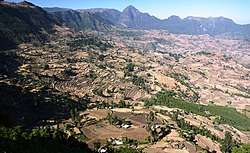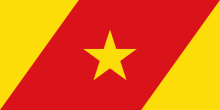Ankober (woreda)
Ankober is one of the woredas in the Amhara Region of Ethiopia. Located at the eastern edge of the Ethiopian highlands in the Semien Shewa Zone, Ankober is bordered on the south by Asagirt, on the west by Basona Werana, on the north by Termaber, and on the east by the Afar Region. Towns in Ankober include Aliyu Amba, Ankober, Gorgo and Haramba.
Ankober አንኮበር | |
|---|---|
Woreda | |
 | |
 Flag | |
| Zone | Semien Shewa |
| Region | Amhara Region |
| Area | |
| • Total | 672.80 km2 (259.77 sq mi) |
| Population (2012 est.) | |
| • Total | 59,810 |
Roads in this Ankober include one built in June 1985 to link the village of Dinki with the rest of the woreda, as part of a "Food-for-Work" program to help victims of the 1984–1985 famine. Until the road was completed, Dinki could only be reached by a two-day mule ride from Debre Berhan down steep mountain slopes. Three years after the road had been completed, two water mills had been established at the village, as well as new fruit plantations and the traditional cotton spinning and weaving industry had been revived.[2]
Demographics
Based on the 2007 national census conducted by the Central Statistical Agency of Ethiopia (CSA), this woreda has a total population of 76,510, an increase of 14.09% over the 1994 census, of whom 38,790 are men and 37,720 women; 4,403 or 5.75% are urban inhabitants. With an area of 672.80 square kilometers, Ankober has a population density of 113.72, which is less than the Zone average of 115.3 persons per square kilometer. A total of 18,274 households were counted in this woreda, resulting in an average of 4.19 persons to a household, and 17,633 housing units. The majority of the inhabitants practiced Ethiopian Orthodox Christianity, with 92.73% reporting that as their religion, while 7.15% of the population said they were Muslim.[3]
The 1994 national census reported a total population for this woreda of 67,061 in 14,430 households, of whom 33,491 were men and 33,570 were women; 3,802 or 5.67% of its population were urban dwellers. The two largest ethnic groups reported in Ankober were the Amhara (92.77%), and the Argobba (7.04%); all other ethnic groups made up 0.19% of the population. Amharic was spoken as a first language by 98.94%, and Argobba was spoken by 0.9%; the remaining 0.16% spoke all other primary languages reported. The majority of the inhabitants practiced Ethiopian Orthodox Christianity, with 92.52% reporting that as their religion, while 7.41% were Muslim.[4]
Notes
- Geohive: Ethiopia Archived 2012-08-05 at the Wayback Machine
- Patrick Webb and Joachim von Braun, Famine and Food Security in Ethiopia: Lessons for Africa (Chichester: John Wiley and Sons, 1994), pp. 60, 107, 113f
- Census 2007 Tables: Amhara Region Archived November 14, 2010, at the Wayback Machine, Tables 2.1, 2.4, 2.5, 3.1, 3.2 and 3.4.
- 1994 Population and Housing Census of Ethiopia: Results for Amhara Region, Vol. 1, part 1 Archived November 15, 2010, at the Wayback Machine, Tables 2.1, 2.7, 2.10, 2.13, 2.17, Annex II.2 (accessed 9 April 2009)